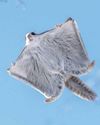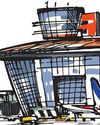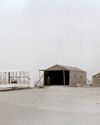
But it was 2,000 miles away through an unknown land. Pulling up roots and moving families and belongings on a difficult and dangerous trip required careful planning. Some families spent a year preparing for the trip.
The journey west began at the Missouri River. Western Missouri cities such as Independence and St. Joseph became bustling “jumping-off” points. Those towns grew into places full of shops and businesses that provided everything pioneers might need—from wagons to livestock and provisions—for their cross-country journey. They also became places where emigrants could gather and meet up.
STURDY WAGONS
Wagons of all types were used, but a smaller version of the Conestoga wagon from the 1700s was especially popular. It was lightweight but sturdy with long, low sides. It usually had a straight bed, making it different from the boat-curved Conestoga. The best wagons were built of hardwood such as hickory, oak, or maple. Hardwoods resisted shrinking in the dry plains air. A light canvas or homespun top stretched over the wagon’s wooden ribs to protect the contents. From a distance, the wagons looked like small ships sailing across the plains. They soon became known as prairie schooners.
At least two teams of oxen were needed to pull a prairie schooner. Two oxen harnessed together with a wooden yoke made a team. Although they were slower than horses or mules, oxen were more reliable and did not have to be unyoked to graze. They also ate prairie grass, which made feeding them easier than horses, who needed hay in their diets.
هذه القصة مأخوذة من طبعة October 2023 من Cobblestone American History Magazine for Kids.
ابدأ النسخة التجريبية المجانية من Magzter GOLD لمدة 7 أيام للوصول إلى آلاف القصص المتميزة المنسقة وأكثر من 8500 مجلة وصحيفة.
بالفعل مشترك ? تسجيل الدخول
هذه القصة مأخوذة من طبعة October 2023 من Cobblestone American History Magazine for Kids.
ابدأ النسخة التجريبية المجانية من Magzter GOLD لمدة 7 أيام للوصول إلى آلاف القصص المتميزة المنسقة وأكثر من 8500 مجلة وصحيفة.
بالفعل مشترك? تسجيل الدخول

Airborne Animals
Humans have taken to the skies in balloons, gliders, and airplanes-but we're not alone among the clouds. Animals of all sorts have evolved to harness wind power.

TAKING OFF
The Wright brothers expected airplanes to “take off,” but even they might be amazed at the way the airline industry has become big business. In the past, it was expensive to send something by plane.

WHY KITTY HAWK?
The Wright brothers searched carefully for the best place to test their gliders and flying machines. Their main concern was for good, steady winds. But they also hoped to find a remote location to allow them to perform tests away from the public eye.

Da Vinci's 4 Designs
Have you ever wondered how a bird flies? Leonardo da Vinci (1452–1519) did. He thought that understanding how a bird flies would provide the key to human flight. So, what did da Vinci learn from birds?

Along Rivers and Through Prairies
An Interview With Dr. Robert Moore

Routes Well Traveled
The United States is not the only country that celebrates its historic routes. But the routes included here are much older!

Last Stop, Independence
For many Oregon Trail pioneers, Independence, Missouri, was the last stop in the United States. Soon after it was founded in 1827, the waterfront town became a strategic city on the Missouri River.

Danger on the Trail
About 20,000 emigrants died on the Oregon Trail. That averaged to about one grave for every 100 yards from the Missouri River to the Willamette Valley. And because pioneers had to keep to a steady pace each day, burials on the trail were hasty. There often was no time to create a marker to note a burial site.

Keeping the Legacy Alive
Several sites in Virginia work to keep alive James Monroe's legacy. In Westermoreland County, Monroe Hall, Monroe's birthplace and the place he called home until he was 16 years old, has been re-created.

The American Colonization Society
In 1821, President James Monroe signed into law the controversial Missouri Compromise.